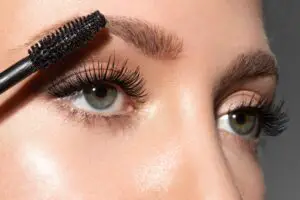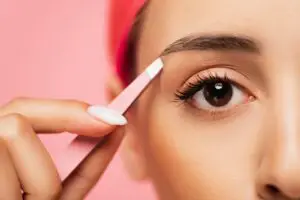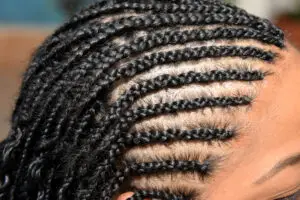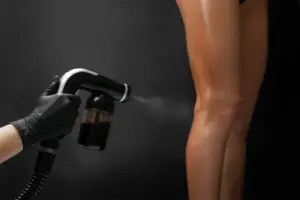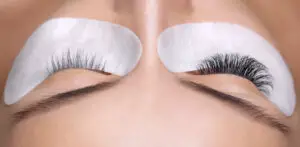Eyebrow growth is a topic of interest for many who have experienced hair loss or had a mishap with tweezers. The process of regrowth can be influenced by factors such as age, genetics, and overall health. It is natural to wonder how long it may take for one’s eyebrows to grow back, as eyebrows play an essential role in framing the face and expressing emotions.
On average, eyebrows usually grow back within four to six months. However, the rate of growth can differ from person to person, as some may see their eyebrows return sooner, while others may experience a longer wait time. Brow hair grows at a slower pace compared to the hair on the head, at roughly 0.14 millimeters per day.
In this article, the factors affecting eyebrow regrowth will be explored, along with tips on how to encourage hair growth naturally through diet, supplements, and other remedies. This knowledge can help set realistic expectations and guide those who seek to restore their eyebrows to their former glory.
Understanding Eyebrow Growth
The Hair Growth Cycle
The hair growth cycle consists of three main phases: the anagen (growing) phase, the catagen (transition) phase, and the telogen (resting) phase. The anagen phase is when hair actively grows, typically lasting 30 to 45 days for eyebrows. The catagen phase is a brief transitional period during which the hair stops growing and the follicle begins to shrink. Finally, the telogen phase occurs when the hair is fully grown and rests before eventually shedding and being replaced by new growth. Understanding the hair growth cycle is essential for managing expectations when it comes to eyebrow growth.
How Eyebrows Differ from Scalp Hair
While the overall structure of the cycle is similar for both eyebrow hair and scalp hair, there are some key differences. The growth cycle for eyebrows is shorter than that of scalp hair, which has an anagen phase lasting from two to six years. This is why eyebrows have a predetermined maximum length, shorter than that of head hair. Because of these differences, it can take four to six months for eyebrows to grow back fully.
The Role of Hair Follicles
Hair follicles play a crucial role in the growth of both scalp hair and eyebrows. These tiny structures within the skin generate hair growth by supplying nutrients and signalling molecules to the hair shaft during the anagen phase. The health of the hair follicles can significantly impact the rate and quality of hair growth. Maintaining good health habits, such as a balanced diet, sufficient sleep, and reducing stress, can positively contribute to healthy hair follicles and, consequently, improved eyebrow growth.
Factors Affecting Eyebrow Growth
Genetic Factors
Genetic factors play a significant role in determining the thickness, length, and growth rate of an individual’s eyebrows. People inherit these traits from their parents and other family members. In some cases, slow or sparse eyebrow growth can be a result of the genetic makeup of an individual.
Health and Lifestyle Factors
A person’s health and lifestyle can greatly impact their eyebrow growth. Some health conditions, such as thyroid disease, autoimmune conditions, and skin conditions, can affect the normal growth cycle of eyebrows. Malnutrition also plays a role, as a balanced diet rich in essential nutrients, vitamins, and minerals is necessary for optimal hair growth. Additionally, stress can impact eyebrow growth by causing hair to enter the resting phase prematurely.
The following factors contribute to healthy eyebrow growth:
- A balanced diet with sufficient vitamins and minerals
- Regular exercise
- Stress management techniques, such as meditation and deep breathing exercises
Aging and Hormonal Changes
As one ages, the natural process of hair growth slows down, leading to thinner eyebrows. This is due to a decrease in the production of hormones like estrogen, which promote hair growth. Hormonal imbalances, such as those experienced during pregnancy or menopause, can also affect the growth and thickness of eyebrows.
In conclusion, various factors, including genetics, health, and lifestyle conditions, contribute to the rate of eyebrow growth. Taking care of one’s overall health and maintaining a balanced diet can promote healthier and faster eyebrow growth.
Common Causes of Eyebrow Loss
Overplucking and Other Physical Traumas
One of the leading reasons for eyebrow hair loss is overplucking. Excessive tweezing, combing, or plucking can cause trauma to the hair follicles, leading to temporary or permanent damage. Other physical traumas that may result in eyebrow hair loss include accidents, burns, or surgeries affecting the eyebrow area. It is essential to handle the eyebrows gently and avoid applying excessive force when grooming.
Medical Conditions and Medications
Various medical conditions can lead to eyebrow hair loss. Hormonal imbalances, such as thyroid issues, can result in thinning and hair loss in both the scalp and eyebrows. Alopecia areata, an autoimmune condition, can cause hair loss in distinct patches, including the eyebrows. Trichotillomania, a psychological disorder, drives individuals to compulsively pull out their hair, resulting in eyebrow loss.
Certain medications can also negatively impact eyebrow growth. Chemotherapy treatments, for instance, can lead to eyebrow hair loss as a common side effect. It is crucial to consult with a healthcare professional to determine if any current medications could be contributing to hair loss.
Skin Conditions and Infections
Skin issues like eczema and psoriasis can cause irritation, itching, and inflammation that disrupt healthy hair growth. Scratching and rubbing the affected areas can further exacerbate the problem, leading to eyebrow hair loss. Infections, such as fungal or bacterial outbreaks, may also impact the condition of the eyebrows. Early diagnosis and appropriate treatment can help minimise the impact of skin conditions and infections on eyebrow growth.
In summary, eyebrow hair loss can result from various factors, including overplucking, physical traumas, medical conditions, medications, and skin issues. Identifying the underlying cause and seeking appropriate treatment is crucial for addressing the issue and promoting healthy eyebrow growth.
Products and Treatments for Eyebrow Regrowth
Over-the-Counter Products
There is a variety of over-the-counter products available to help support eyebrow growth. Eyebrow serums, such as Talika Lipocils Platinum, and brow conditioners, like RevitaBrow Advanced Eyebrow Conditioner, usually contain peptides, biotin, and other nourishing ingredients that can enhance and promote healthier eyebrows. Some options to consider are:
- Talika Lipocils Platinum Double-Serum Eyebrow Growth Activator
- Vegamour GRO Brow Serum
- The Body Shop Long Game Brow & Lash Serum
- Rodial Lash & Brow Booster
Prescription Treatments
There are a few prescription treatments that can help with eyebrow growth. Bimatoprost, an active ingredient in Latisse, is specifically designed for eyelash growth, but has been found to work on eyebrows as well. Additionally, minoxidil (Rogaine) is commonly used for hair regrowth on the scalp, and may also promote eyebrow growth. However, it is essential to consult with a doctor before using any prescription treatments, as there may be possible side effects.
Natural Remedies
Some natural remedies are believed to support eyebrow growth. One popular option is castor oil, which is said to help nourish eyebrow hair follicles and promote growth. To use castor oil, simply apply a small amount on the eyebrows and massage gently before bedtime. Remember to perform a patch test before trying any natural remedies, as they may cause skin irritation for some individuals.
Vitamins and Nutrition
Nutrition plays a significant role in maintaining healthy hair, including eyebrows. Consuming a balanced diet, rich in essential nutrients, is crucial for supporting hair growth. Biotin, a B-vitamin, is particularly important for hair health, and deficiencies can lead to hair thinning and breakage. Some supplements, like Nutrafol, can help provide the necessary vitamins and nutrients to support hair growth, including eyebrow regrowth. Ensuring proper intake of vitamins through diet or supplements can make a difference for those looking to improve the appearance of their eyebrows.
How to Maintain and Protect Your Eyebrows
The Do’s and Don’ts of Eyebrow Maintenance
When it comes to maintaining your eyebrows, it’s essential to follow certain guidelines to ensure healthy growth. Firstly, avoid over-plucking your eyebrows, as this can lead to thinning and potential damage to the hair follicles. Use sharp, quality tweezers to remove only the stray hairs, always being careful not to remove hairs from the main body of the brow. Additionally, do not use harsh products or over-exfoliate the brow area to prevent irritation.
It’s important to nourish and protect your eyebrows to promote growth. Consider incorporating products such as brow gels or conditioners into your routine to moisturise and strengthen the eyebrow hairs. Furthermore, make use of vitamins and supplements specifically aimed at hair growth if your diet lacks essential vitamins and minerals.
Cosmetic Products and Techniques
Using the right eyebrow makeup can aid in enhancing your natural brows, giving them a fuller and more defined appearance. Invest in quality eyebrow pencils to fill in any gaps or sparse areas. Experiment with different shades to find the best match for your hair colour and skin tone. When applying makeup, always use gentle strokes to mimic individual hair strands.
Another option is to use brow pro products such as powders and pomades, which can help create volume and definition for your eyebrows. Using a combination of products can lead to better results. Remember, when removing makeup, always be gentle to avoid damaging the sensitive eye area and ensure all products are removed to prevent clogging and irritation.
Tinting, Microblading and Other Treatments
For those seeking more permanent or semi-permanent solutions to enhance their eyebrows, treatments such as microblading and brow tinting can offer impressive results. Brow tinting involves using a dye to temporarily change the colour of your eyebrow hair, which can make them appear fuller. However, these treatments should only be performed by qualified and experienced professionals. Conduct thorough research and read reviews before choosing a practitioner.
Seeking Professional Help
When to See a Dermatologist
If you find that your eyebrows are not growing back after several months, it may be time to seek the help of a board-certified dermatologist. They can assess the situation and determine the underlying cause of your eyebrow hair loss. Factors such as hormonal imbalances, nutritional deficiencies, and medical conditions can all contribute to eyebrow hair loss. A dermatologist may recommend treatments such as topical medications or supplements to stimulate hair growth and address any underlying issues.
Hair Transplant Surgery for Eyebrows
In some cases, a dermatologist may suggest considering hair transplant surgery for eyebrows. This is particularly relevant when eyebrow regrowth is not responsive to other treatments or if there is significant scarring in the area. This procedure involves transplanting individual hair follicles from a donor site, typically from the back of the head, to the eyebrow area. The transplanted hairs will grow and blend in with your existing eyebrow hairs over time, creating a natural appearance.
It is essential to have this procedure performed by a reputable and experienced hair transplant specialist to ensure the best results. Keep in mind that hair transplant surgery may not be suitable for everyone, and it is crucial to weigh the potential risks and benefits along with the costs involved. Ultimately, consulting with a dermatologist and discussing all available treatment options will help you make an informed decision on how to restore your eyebrows.
Conclusion
In conclusion, regrowing eyebrows requires patience as the process can take some time. On average, it takes approximately four to six months for eyebrows to grow back fully. However, this timeframe may vary depending on individual factors, the extent of hair removal, and overall hair growth rate.
It is crucial to understand that the regrowth process of eyebrows is usually slower than the hair on your head, growing at a rate of about 0.14 millimeters per day. Moreover, the growth timeline may differ for plucked eyebrows, as the roots of the hair stay within the skin, affecting the hair follicles’ ability to produce new hair efficiently.
In order to encourage the growth of eyebrows, several helpful practices can be adopted. These may include maintaining proper nutrition, using eyebrow serums, and refraining from over-plucking or unnecessary hair removal techniques. Adopting such measures will aid in the regrowth process, allowing your eyebrows to grow back more quickly and healthily.
Ultimately, regrowing eyebrows successfully comes down to understanding the factors that impact the regrowth process, exercising patience, and taking appropriate care of the affected eyebrow area. By doing so, individuals can expect their eyebrows to grow back gradually and return to their desired appearance within a reasonable time frame.

I’m Jennifer a beauty and wellness expert. I believe in promoting a sustainable and healthy lifestyle from within. Helping people feel good is my passion; whether it’s teaching yoga or offering skincare advice.


